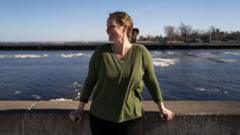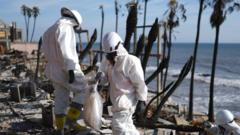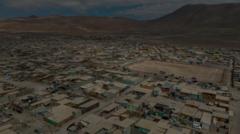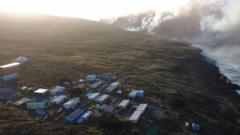With over 150,000 residents forced out due to devastating wildfires in Los Angeles this month, many Californians, like Christina Welch and Jamie Beck Alexander, are seeking refuge in cities touted as 'climate havens.' Their migration reflects the increasing urgency of escaping climate-related disasters, prompting discussions about the preparedness of potential new homes.
California's Climate Migrants Seek Safety in Alternative Havens

California's Climate Migrants Seek Safety in Alternative Havens
As wildfires rage, residents flee to cities perceived as safer from climate disasters.
More than 150,000 Californians recently evacuated due to fierce wildfires sweeping across Los Angeles County, a region infamous for climate crises. Christina Welch, displaced once by the 2017 Tubbs fire and again by the Kincade fire in 2019, chose to relocate to Duluth, Minnesota. “I realized I couldn’t keep facing the anxiety of wildfires,” she recounted, poignantly illustrating the growing concern among residents.
The recent surge in wildfires serves as a stark reminder of the potentially dire impacts of climate change, forcing thousands to reconsider their living situations. Climate experts, while noting the ongoing population decline in California, anticipate an increase in migrations due to escalating climate events. Derek Van Berkel, a data science professor, emphasizes the importance of proactive community preparation for an impending wave of potential newcomers fleeing from California.
The last three years alone saw over 15,000 structures consumed by wildfires, and projections by the state attorney general's office warn that rising sea levels may place up to 500,000 residents in flood-prone areas by the end of the century. Despite this, current climate migration trends show only localized movements as residents shift inland or elevate their homes to mitigate flooding risks.
Still, individuals like Jamie Beck Alexander have sought out cities away from California that promise relative stability in the face of climate-related disasters, deeming Duluth a “climate haven.” This burgeoning trend corresponds with research by Jesse Keenan, who compiled a list of safer locales expected to suffer less from climate impacts. Duluth, with its ample freshwater access from the Great Lakes, has become increasingly desirable.
However, many cities are unprepared for an influx of new residents, particularly smaller municipalities that would require extensive investment for necessary infrastructure and services. Additionally, as influxes of climate migrants become more pertinent, issues like housing availability and affordability have already begun to surface in Duluth and similar locales.
In a cautionary tale, Kelsey Lahr, who relocated to Asheville, North Carolina, in search of climate resilience, experienced a devastating hurricane that obliterated her new home. She, along with many others, has learned that no location is entirely insulated from climate change effects. The reality is that without addressing the fundamental causes of climate change, individuals will continually find themselves seeking new refuge.
With shifting geography, rising temperatures, and unpredictable weather patterns prevalent, some argue that the concept of 'climate havens' may be misleading. As they adapt to new environments, recent migrants are left to confront the irrefutable truth: climate change is an inescapable part of their lives, compelling them to evaluate which risks they could best manage in their search for safety.






















